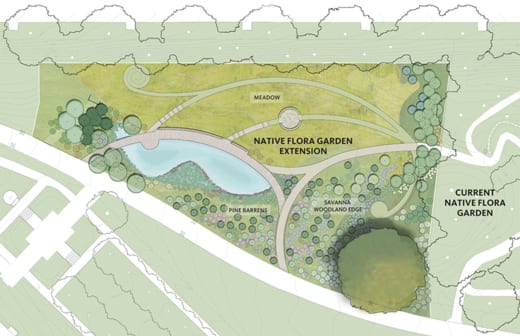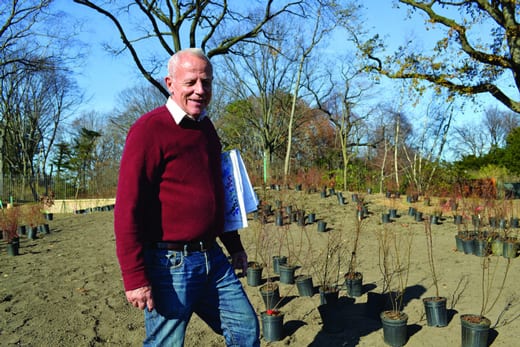RIGHT HERE IN BROOKLYN
The unveiling of the new Native Flora Garden at the Brooklyn Botanic Garden last June was exhilarating. Tiny ferns, grasses, wildflowers, shrubs, trees, and several judiciously strewn lichen-covered logs brought to mind a walk on the plain, enlivened with rhythms that recalled the curves and loops of Abstract Expressionism. Arshile Gorky done up in Little Blue Stem. Because they were so new, each plant was still a separate entity and the patterns were laid bare. A rare and hopeful experience.

The garden’s designer is Darrel Morrison, a New York-based landscape architect who began his career using the same rigidly monotonous plant palette as his confederates but soon discovered a richer, more complex approach that utilized mainly native species, organized in the sorts of “rivers and drifts,” in his words, that they tend to create of their own accord. He considers the new garden his masterwork, a summing up of a lifetime observing plants in the wild.

For the gala held to celebrate the new garden last spring Darrel prepared a set of poetic remarks about the new garden, whose cadence also brings to mind the fifties:
. . . . .right here in Brooklyn, next to Flatbush Avenue:
A tiny glimpse of the grandeur of the tall, waving grasses that once occupied vast stretches of the Hempstead Plain on Long Island: Little Bluestem, Purple Lovegrass, Purpletop, Indiangrass, Big Bluestem and Switchgrass. Along with Butterfly Weed, Prairie Phlox, Showy Goldenrod, Pale Blue Aster, New York Ironweed, Joe Pyeweed, and more
. . . . .right here in Brooklyn, next to Flatbush Avenue.
Or to see the subtle, sometimes stark beauty of the Pine Barrens of New Jersey and Long Island: the picturesque Pitch Pines, scruffy Scrub Oaks, pink-flowered Sheepberry, Bracken Fern and Sweet Fern. And to see, up close, miniature Pine Barrens gardens of Pyxie Moss, Haircap Moss; silvery mats of Cladonia lichens, and Birdfoot Violet and Prickly Pear Cactus
. . . . right here in Brooklyn, next to Flatbush Avenue.
Or to see a vignette of a Pine Barrens pond and bog, with Leatherleaf shrubs, Swamp Azaleas, Woolly Broomsedge, Woolgrass, Cottongrass, Blue Flag Iris, and (soon) Pitcher Plants, Rose Pogonia and Grass Pink Orchids.
And to see, in October, beyond the pond, the flaming red foliage of Black Gum, and Red Maple trees next to the dark green of Atlantic White Cedars.
. . . .right here in Brooklyn, next to Flatbush Avenue.
Darrel was right about October. I was there a few weeks ago with the LALH board to see the garden in its fall garb and, indeed, the Black Gum was flaming and the tiny plants from last spring had exploded into fields of waving grain.

There is a fine interview on the Brooklyn Botanic Garden website that speaks to the philosophy of the art that Darrel Morrison has practiced for five decades. There he concludes:
Unlike most artists, we garden designers have the luxury of working with the fourth dimension—time. So what we’re creating here will always be a work in progress. We set it in motion and let it take off, and people will see a different garden each time they come. Visit in the late spring and you’ll see a blanket of small, colorful flowers in bloom, but come again in October and you’ll see a different place, with tall grasses waving like ocean waves. And then the following year, there will be more differences still. It will never be “done,” and that’s one of the most exciting things about working with plants. That’s exactly how it should be.

Go visit when you can. The garden will transport you–to the plains of Long Island, the pine barrens of New Jersey, and beyond.